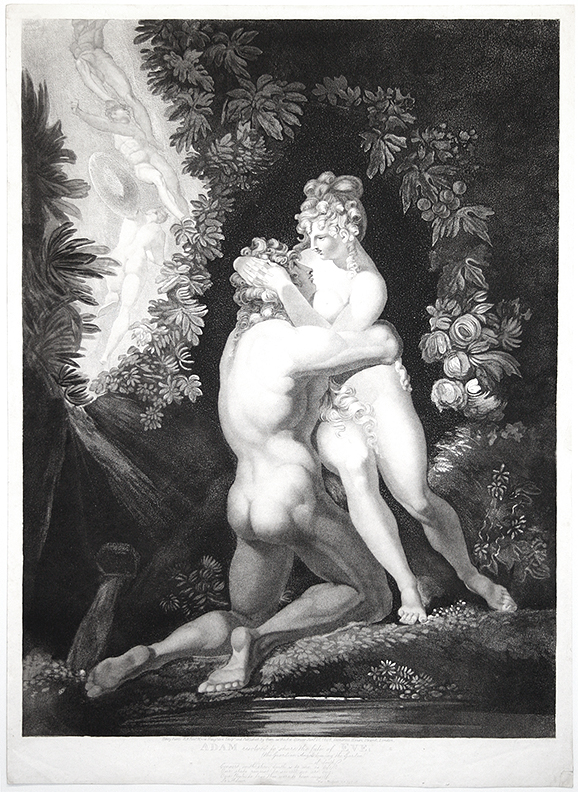- Henry Fuseli
Johann Heinrich Füssli- ( Swiss, 1741 - 1825 )
Original etching. Signed and annotated in the plate: "Henry Fuseli RA Prin.t Moses Haughton Sculp.t and Published by them as the Act directs Jany 20, 1806, Somerset House, Strand, London." "Adam resolved to share the fate of Eve; (the Guardian Angels leaving the garden) if death Consort with thee, death is to me as life; Our state cannot be sever'd, we are one. One flesh; to lose thee were to lose myself..."
Sheet size: 22 1/2" x 16 1/4"
Fuseli was born in Zürich, Switzerland, the second of eighteen children. His father was Johann Caspar Füssli (1707-82), a painter of portraits and landscapes, and author of Lives of the Helvetic Painters. He intended Henry for the Church, and sent him to the Caroline college of Zurich, where he received an excellent classical education.
After taking priest orders in 1761 Fuseli was forced to leave the country as a result of having helped Lavater to expose an unjust magistrate, whose powerful family sought revenge. He first travelled through Germany, and then, in 1765 at the suggestion of the British Ambassador in Berlin, who had been impressed by his drawings, came to England. Eventually, he became acquainted with Sir Joshua Reynolds, to whom he showed his drawings. Following Sir Joshua's advice he devoted himself wholly to art. In 1770 he made an art-pilgrimage to Italy, where he remained till 1778, changing his name from Füssli to Fuseli. He engrossed in the study of Michelangelo, whose elevated style he sought to emulate for the rest of his life.
Early in 1779 he returned to Britain, taking in Zürich on his way. On his return he exhibited highly imaginative works which secured his reputation at the Royal Academy. He found a commission awaiting him from Alderman Boydell, who was then organizing his famous Shakespeare Gallery. Fuseli painted a number of pieces for Boydell, and published an English edition of Lavater's work on physiognomy. In 1788 Fuseli married Sophia Rawlins (originally one of his models), and soon after became an associate of the Royal Academy.
In 1799 Fuseli was appointed professor of painting to the Academy. Four years afterwards he was chosen as keeper, and resigned his professorship; but he resumed it in 1810, and continued to hold both offices until his death at the advanced age of eighty-four, and was buried in the crypt of St Paul's Cathedral.
Fusely was a much respected and influential figure in his lifetime, but his work was generally neglected for about a century after his death until the Expressionists and Surrealists saw in him a kindred spirit. His work has something of the imaginative intensity of his friend William Blake. Fuseli's extensive writings on art include Lectures on Painting (1801) and a translation of Winckelmann's Reflections on the Painting and Sculpture of the Greeks (1765).
- ( Swiss, 1741 - 1825 )

